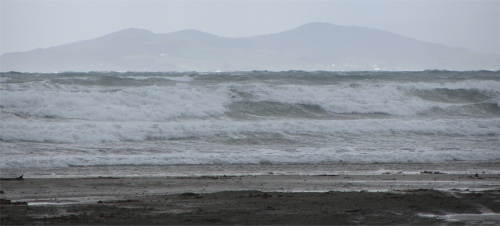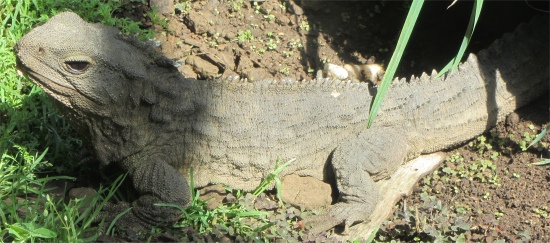 Tuatara |
Fortunately the smoke had cleared before a young woman arrived to sort out her breakfast. I gave her a bright, "Good morning!" She just ignored me. Since all the other campers had gone, I deduced she must be one of the cabin dwellers. We breakfasted in silence at opposite ends of the room. However, as we washed out cutlery and crockery, we had to use adjacent sinks. "What is there to do in Invercargill on a rainy day?" I asked, more of a means of starting a conversation than an earnest enquiry. She gave me a startled look, as if she had never been spoken to before. Then a solitary cog started engaging in her brain, and she replied, "Well, you can go paintballing, or go-karting, or go to the beach." I stared outside at the collapsing heavens and the rivulets flowing down the driveway. "Ahhh... ," I said slowly, and knew I didn't want to carry on the conversation.
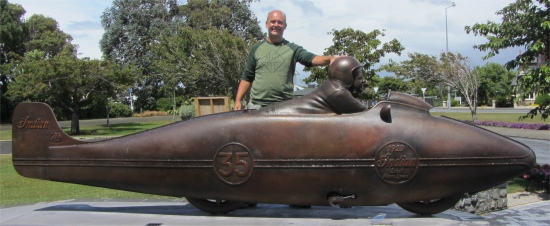 Burt Munro in Action Sculpture with a Bit of Sunshine |
I cursed the rain as I was about to leave the office, and the woman said that a week ago, water trucks had been delivering water to certain districts. I found out later that they had just suffered the longest drought in 47 years. We both looked outside at the sheets of water tumbling down, and just smiled.
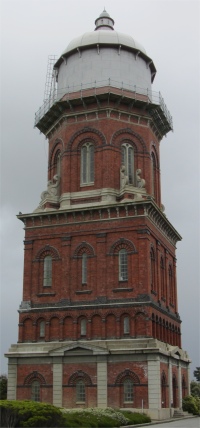 Invercargill Water Tower |
The city was forward looking in an academic sense. In 2000, tertiary education institutions were set up with community contributions offering free tuition to New Zealand and Australian students. The resulting increase in student population had had a positive impact on the arts and nightlife scene. Discovery of possible oil reserves nearby has also led to new investment in the town. Despite all this, the town looked tired, and had one facelift too many.
The 1889 redbrick Water Tower provided a handy focal point in the city, but for me the gem was the Southland Museum and Art Gallery located in a large, white pyramid. An extremely interesting exhibition, entitled "Beyond the Roaring Forties", focused on New Zealand's sub-Antarctic islands, tiny windswept clusters lying hundreds of kilometres apart between the mainland and Antarctica. A human element was attached to these small islands, first of all how they were used by seal hunters and whalers, and also the moving accounts of people who had been ship wrecked on these desolate islands. Other displays covered climate, wildlife and more shipwrecks, all pertinent to Southland.
Other exhibits included local and Maori art, natural history, geology, Victoriana, an Anne Frank exhibition, and most interestingly, an exhibition on Burt Munro, an Invercargill hero whose speed motorbike achievements were captured in the 2005 film, The World's Fastest Indian. As a young insolent tearaway, he blew all his life savings on a motorbike in his late teens, progressed to making his own bikes using the beach to make his castings, and was still breaking land speed records in his 70s.
However, the real stars were the tuatara. These miniature dinosaur-like reptiles were unique to New Zealand. Apparently, these creatures had remained unchanged for over 225 million years, though how scientists can tell that is well beyond me, but they were proclaimed "living fossils". They were around before its adopted nation came into existence. On display in the tuatarium was the 100+ year-old-Henry, but his one-time mate, the 80 year-old-Mildred, was no longer around. They became parents in 2009. Crumbs, how was their love-making, their movements would make dead-slow look positively speeding. There was of course an exception to that rule; they snatched insects with an incredibly swift snap of the jaws, the ultra-slow chew must have been excruciating for the victims. Tuatara can live for 500 years, so time for some more kids yet before the grandkids come along.
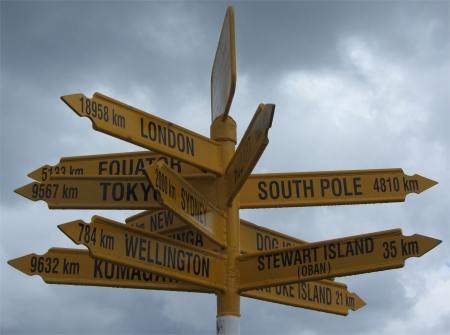 Signpost at Stirling Point |
Next to the museum was Queens Park, and since the rain had abated, I took a quick stroll around. The summer flowers were doing their bravest to keep upright in the wind, and all the ducks seemed to be out on the grass. On the way out, I spotted a toilet and made a bee-line for it. It was one of these automated varieties: press a button to get in, press a button to close the door, music suddenly appears from nowhere, do your business, put your hands under an area for soap, then water, then a dryer, and press a button to open the door and leave, which also flushes the loo for you. One thing I can say about New Zealand, there are public loos virtually everywhere. They are all free, and they are all clean.
I got back to my waggon as the next shower rolled in, so for want of something better to do, I drove down to Bluff, the departure point for ferries across the Foveaux Strait to Stewart Island, New Zealand's third main island. It was only a small place, and since it was one of the earliest places to be regularly visited by whalers, it had the reputation of being the oldest European settlement in the country, when it was known as Campbelltown. It was, and still is, the ideal place to shelter ships and boats from the elements of Foveaux Strait.
I did the obligatory visit to Stirling Point to visit the signpost pointing to cities and islands; far more impressive than the Slope Point signpost. The point was named after Captain William Stirling, and the area was originally home to a whaling station established by Stirling for Johnny Jones in 1836. Then it was a quick trip to the Maritime Museum which featured much on Bluff and the Foveaux Strait area. Pride of place was the oyster boat, the Monica, which sat outside on dry land. Bluff was famous for its oysters. To round off my short excursion to Bluff, I drove up to the lookout to get a great panoramic view across to Stewart Island, Ruapuke and Dog Islands, Tiwai Peninsula with its huge aluminium smelting plant, Centre Island and the southern mountains.
 Dog Island with New Zealand's Tallest Lighthouse |
I returned to camp and popped into the reception to pay my dues for the night and see if it was possible to buy a beer at the bar (the site was mainly a motel with an attached restaurant and bar - camping was a side-line). Alan was there and told me, "Just follow the young lady there, she'll sort you out a drink." I followed her into the restaurant section which had a bar at one end, and she introduced herself as Alan's daughter. "Where is everyone?" I asked, gazing around the vacant room. "We had a party of 20 or so earlier this evening, but they had to be off early," she replied. She served me a beer, and asked where I was from. Rather than give a straight answer, I thought I'd tease her and came out with, "Have a guess." "Scotland," was her first guess, and "Wales," her second. I put her out of her misery, explained that my northern vowels might have confused her, and she laughed out loud. We talked about the Kiwi language skills; she had found the compulsory Maori lessons boring.


